Shoe buckle
Shoe buckles are fashion accessories worn by men and women from the mid-17th century through the 18th century. Shoe buckles were made of a variety of materials including brass, steel, silver or silver gilt, and buckles for formal wear were set with diamonds, quartz or imitation jewels.[1]
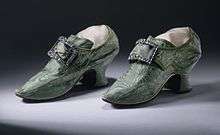
History
Buckled shoes began to replace tied shoes in the mid-17th century:[2] Samuel Pepys wrote in his Diary for 22 January 1660 "This day I began to put on buckles to my shoes, which I have bought yesterday of Mr. Wotton."[3] The fashion at first remained uncommon enough though that even in 1693 a writer to a newspaper complained of the new fashion of buckles replacing ribbons for fastening shoes and knee bands.[4] Separate buckles remained fashionable until they were abandoned along with high-heeled footwear and other aristocratic fashions in the years after the French Revolution,[5] although they were retained as part of ceremonial and court dress until well into the 20th century.[6] In Britain in 1791 an attempt was made by buckle manufactures to stop change in fashion by appealing to the then Prince of Wales Prince George.[4] While the prince did start to require them for his court this didn't stop the decline of the shoe buckle.[4] It has been suggested that the decline drove the manufacturers of steel buckles to diversify into producing a range of cut steel jewellery.[4]
Knee buckle
Knee buckles are used to fasten the knee-high boots just below the level of the knee.
Gallery
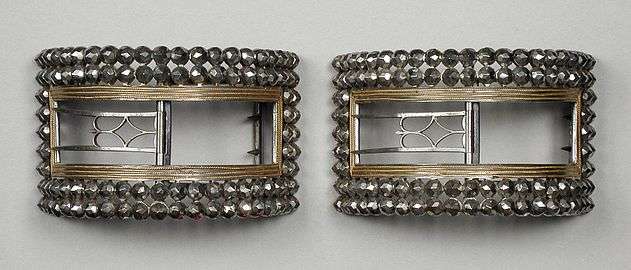 Man's steel and gilt wire shoe buckles, England, c. 1777–1785 LACMA M.80.92.6a-b.
Man's steel and gilt wire shoe buckles, England, c. 1777–1785 LACMA M.80.92.6a-b.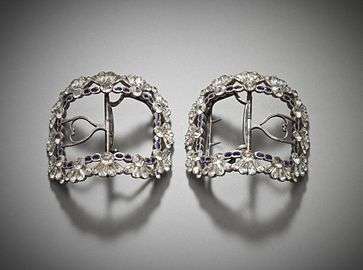 Woman's silver and steel shoe buckles with paste stones, 1780–85. LACMA M.80.92.1a-b
Woman's silver and steel shoe buckles with paste stones, 1780–85. LACMA M.80.92.1a-b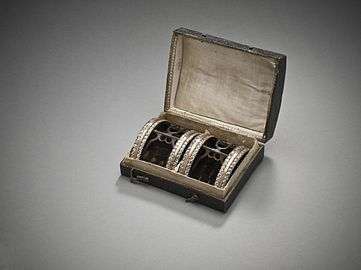 Man's shoe buckles with case. Paste stones with gilded-copper-alloy trim on silver and steel, France, c. 1785. LACMA M.2007.211.829a-b.
Man's shoe buckles with case. Paste stones with gilded-copper-alloy trim on silver and steel, France, c. 1785. LACMA M.2007.211.829a-b.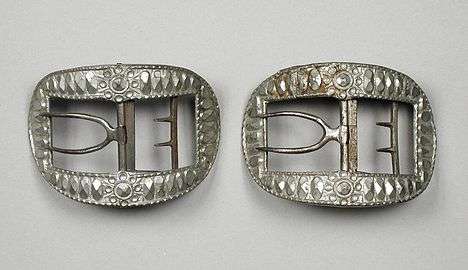 Man's cut steel shoe buckles, United States, 1780s. LACMA 42.16.23a-b.
Man's cut steel shoe buckles, United States, 1780s. LACMA 42.16.23a-b.
See also
- 1700–1750 in fashion
- 1750–1775 in fashion
- 1775–1795 in fashion
Notes
- Takeda and Spilker (2010), p. 183
- Tortora and Eubank (1995), p. 190
- "The Diary of Samuel Pepys". Retrieved 16 April 2011.
- Clifford, Anne (1971). Cut-Steel and Berlin Iron Jewellery. Adams & Dart. pp. 18–19. ISBN 9780239000699.
- Tortora and Eubank (1995), p. 272
- "Victoria and Albert Museum: Shoe Buckles". Retrieved 20 April 2011.
References
| Wikimedia Commons has media related to Shoe buckles. |
- Takeda, Sharon Sadako, and Kaye Durland Spilker, Fashioning Fashion: European Dress in Detail, 1700 - 1915, Prestel USA (2010), ISBN 978-3-7913-5062-2
- Tortora, Phyllis G. and Keith Eubank. Survey of Historic Costume. 2nd Edition, 1994. Fairchild Publications. ISBN 1-563-67003-8
